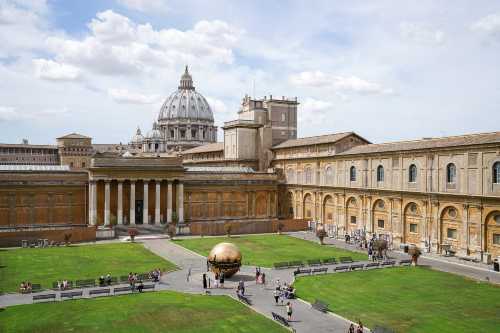Soldiers in colorful striped uniforms are always seen standing guard at the right aisle entrance of St. Peter's Basilica in the Vatican. They are the Swiss Guard, the Pope's personal bodyguard and one of the world's oldest active military forces. This unit is composed entirely of young men from Catholic Switzerland. Since the Middle Ages, Swiss mercenaries have been renowned in Europe for their strict discipline, bravery, and loyalty, often employed by monarchs as personal guards. In 1506, amidst the turmoil of war in Italy, Pope Julius II recruited 147 Swiss soldiers to protect the Vatican, establishing the Swiss Guard. Every January 22nd, the Swiss Guard holds a solemn oath-taking ceremony to commemorate their arrival in Rome. The Swiss Guard's most famous historical event is the 1527 Sack of Rome, when Pope Clement VII allied with King Francis I of France against the increasingly powerful Charles V (Carlos I of Habsburg Spain). In retaliation for the Pope's betrayal, Charles V acquiesced to the attack on Rome. Charles's army, lacking supplies and unpaid, suffered from low morale and hunger. After the Duke of Bourbon was shot and killed during the siege, the army lost control and began looting, slaughtering, and destroying the city on a massive scale. Rome fell within hours, leaving the defenders powerless. However, the Swiss Guard fought bravely and successfully escorted Pope Clement VII to the Castel Sant'Angelo for refuge. The Swiss Guard was nearly annihilated, with only 42 of 189 soldiers surviving. Castel Sant'Angelo, where the Pope took refuge, was originally a mausoleum built by Emperor Hadrian in 123 AD for himself. It is located on the banks of the Tiber River. It was converted into a fortress in the Middle Ages and served as a military refuge for the Pope. In 1277, Pope Nicholas III ordered the construction of a secret passage, the Passetto di Borgo, connecting the Castel Sant'Angelo to the Vatican, allowing for an emergency papal retreat. This passage played a key role in the Sack of Rome in 1527. Castello's name stems from a legend: During the plague of 590 AD, Pope Gregory I saw the angel St. Michael appear on the castle's summit. He sheathed his sword, symbolizing the end of the plague. From then on, Hadrian's Mausoleum was renamed "Castle Sant'Angelo," and a statue of St. Michael with his sword drawn was erected on top. The bronze statue we see today was recast by Peter Anton von Verschaffelt in 1753. Ponte Sant'Angelo, connecting the Castel Sant'Angelo to Rome, was built in 134 AD and is the main access point to the fortress. The bridge's most famous features are the ten angel statues depicting the instruments of Christ's Passion, designed by the Baroque master Gian Lorenzo Bernini and his studio. Two of the sculptures, the "Angel with the Crown of Thorns" and the "Angel with the Nail," were sculpted by Bernini himself; the originals are now housed in the Castel Sant'Angelo, while replicas are displayed on the bridge. Castel Sant'Angelo once housed a prison, and as a result, a legend casts a shadow over the site at night. It is said that every year at midnight between September 10th and 11th, the ghost of a woman named Beatrice Cenci appears on the bridge. She slowly walks across the bridge, carrying a bloody human head. At the stroke of midnight, she turns toward the Tiber River and disappears in the wind and darkness. Beatrice Cenci was a Roman noblewoman who, unable to tolerate her father's tyranny and incest, conspired with her family to murder him. She was sentenced to death and publicly beheaded in front of the Castel Sant'Angelo in 1599. The crowd witnessed her fearless walk toward the guillotine, and one witness is said to be the painter Caravaggio. This experience likely inspired his later famous painting, "Judith Beheading Holofernes." Judith, with a stern and resolute expression, raises her sword to behead the enemy commander. The scene is bloody yet majestic. This tension, a mixture of pain, justice, and violence, is strikingly similar to Beatrice's fate. In Rome's Palazzo Barberini, there is a painting called "Portrait of Beatrice Cenci" by the Italian Baroque painter Guido Reni. This portrait has become a symbol of Cenci's memory for generations to come. The painting employs soft light and shadow, showcasing her holy and serene features. However, the overall image is shrouded in an atmosphere of unease, as if narrating her grievances and the call of her soul. In his travelogue, Notes on France and Italy, American author Nathaniel Hawthorne wrote, "It is the most unforgettable face I have ever seen." Many subsequent artists and writers have been deeply moved by this painting and the story behind it. Percy Bysshe Shelley used her life as the model for his epic poem, The Silence, to criticize tyranny and injustice. Stendhal referenced her repeatedly in his works, viewing her as the embodiment of history and emotion. Castle Sant'Angelo, originally the mausoleum of Emperor Hadrian, now stands as a meeting point for Roman memory: history, faith, myth, and art intersect within this ancient fortress. This scene from the third act of Puccini's opera "Tosca" features the opera's heroine, Tosca, leaping from the walls of Castel Sant'Angelo. Today, Castel Sant'Angelo often appears in dramas, such as the films "The Da Vinci Code" and "Angels and Demons." Beatrice Cenci's midnight apparition may not be a vengeful spirit, but rather a gaze upon truth and an enduring memory, silently telling an unforgettable story. #Europe #Vatican #Rome #Switzerland #Italy #TravelRecommendations #TravelPlanning
Michael1104
Popular Trip Moments
Vatican | Free visit to St. Peter's Basilica | Vatican Rome ‖ The Intersection of Memory and Glory in the Eternal City | Rome’s Silent Storytellers 🏛️✨ | Rome Reimagined: Eternal Reflections by the Tiber 🌿🏛️ | A Must-Visit in Rome: A One-Day Tour Guide to the Tiny Country Vatican City | ⛪ St. Peter’s Basilica – The Soul of Vatican City | Spooky Rome Night🎃 | St. Peter's Basilica in the Vatican is so beautiful that people can't leave | Vatican City: The World's Smallest Yet Most Beautiful Country | St. Peter's Basilica (Basilica di San Pietro in Vaticano) | The Place Where the Art of the Gods Breathes, Vatican Museums (Musei Vaticani) | Vatican Museums — A Sanctuary of Genius Artists | A must-see for European-style ancient buildings🏛 | Pio-Clementino Museum – The Crown Jewel of Ancient Sculpture in the Vatican | Rome 2 days 1 night 🇮🇹 | Golden Hour Glow✨ | Basilica Majesty✨ | Vatican City | Vatican City | 🎨 Vatican Museums — A Half-Day Journey Through Art & History | Pilgrimage to the Holy City of Vatican! ✨ | 【Vatican】St. Peter's Basilica: One of the World's Largest Churches | Rome and Vatican City Travel Notes | A Journey Through Art, History, and Faith | Vatican City's Artistic Paradise 🎨 | One Day in Vatican City: Tips & Tricks 🇻🇦 | [Vatican City🇻🇦] Climb the dome of the cathedral❗
Recommended Attractions at Popular Destinations
Popular Attractions in Kuala Lumpur | Popular Attractions in Iguazu National Park(Argentina) | Popular Attractions in Walt Disney World Resort | Popular Attractions in Dubai | Popular Attractions in Paris | Popular Attractions in Los Angeles | Popular Attractions in Barcelona | Popular Attractions in Bangkok | Popular Attractions in Rome | Popular Attractions in London | Popular Attractions in Singapore | Popular Attractions in Osaka | Popular Attractions in New York | Popular Attractions in Zanzibar Island | Popular Attractions in Bali | Popular Attractions in Melbourne | Popular Attractions in Beijing | Popular Attractions in Shanghai | Popular Attractions in Sydney | Popular Attractions in Las Vegas | Popular Attractions in Tokyo | Popular Attractions in Chefchaouene | Popular Attractions in Kyoto | Popular Attractions in Phuket | Popular Attractions in West Lake | Popular Attractions in Chengdu | Popular Attractions in Florence | Popular Attractions in Madrid | Popular Attractions in Istanbul | Popular Attractions in Jungfrau Region
Popular Restaurants in Vatican
Popular Ranked Lists
Top 10 Best Things to Do in Nagasaki | Popular Luxury Hotels in Central Java | Top 50 Must-Visit Restaurants in Phuket | Top 50 Must-Visit Restaurants in Chiang Mai | Popular Luxury Hotels in Helsinki | Top 50 Must-Visit Restaurants in Bali | Top 50 Must-Visit Restaurants in Hanoi | Top 50 Must-Visit Restaurants in Barcelona | Top 50 Must-Visit Restaurants in Singapore | Top 50 Must-Visit Restaurants in Seoul | Popular Luxury Hotels in Incheon | Top 50 Must-Visit Restaurants in Melbourne | Top 50 Must-Visit Restaurants in Shanghai | Popular Luxury Hotels in Aba Prefecture | Popular Luxury Hotels in Genting Highlands | Popular Luxury Hotels in Busan | Top 50 Best Things to Do in Saint Petersburg | Popular Best Things to Do in Boracay Island | Top 50 Must-Visit Restaurants in Kyoto | Popular Luxury Hotels Near Longnan | Popular Premium Hotels in Hsinchu | Top 50 Best Things to Do in Milan | Popular Premium Hotels in New Taipei City | Popular Luxury Hotels in San Francisco | Popular Premium Hotels in Taitung | Top 50 Best Things to Do in Melbourne | Top 10 Best Things to Do in Doha | Popular Luxury Hotels in Bora Bora | Top 10 Local Restaurants in Lushan Global Geopark | Top 50 Must-Visit Restaurants in Jeju
About
Payment methods
Our partners
Copyright © 2025 Trip.com Travel Singapore Pte. Ltd. All rights reserved
Site Operator: Trip.com Travel Singapore Pte. Ltd.
Site Operator: Trip.com Travel Singapore Pte. Ltd.























